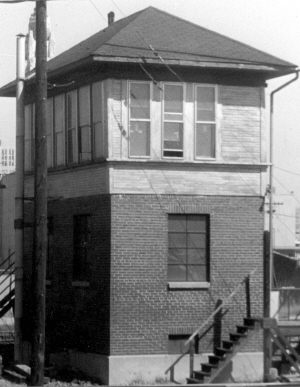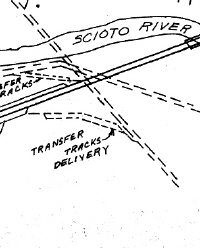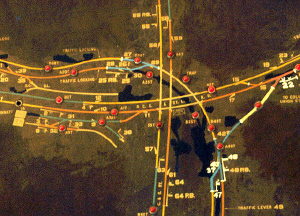|
|
Little Miami "LM" Cabin (A.K.A. Scioto Tower)[1] |
|
Click here for photos
Click here for drawing |
Beginning in May, 1868, LM Crossing consisted of a small building for the telegrapher/operator and a tilting target, which when in the horizontal position signified that Columbus and Hocking Valley (C&HV) trains could use the crossing and when in the vertical position Pittsburgh Cincinnati Chicago & St. Louis (PCC&StL) trains could pass. Every crossing with another railroad had a tilting target in those days and the position of the target when trains could pass varied with each crossing. The same tower might have a different name on different railroads. It was LM for Little Miami on the C&HV ... C&O, but the operator had better answer Scioto when the PCC&StL and later the Toledo and Ohio Central (T&OC) called. Since the C&HV was the junior railroad at the crossing, it would have supplied the telegraphers to operate the crossing. The Columbus Hocking Valley & Toledo (CHV&T) double tracked its line from Mound Street Yard to Ackerman about 1893. The Toledo and Ohio Central built its line from West Columbus to Truro in 1894 and 1895 passing LM. The Columbus, Hocking Valley and Toledo (CHV&T), successor to the C&HV, signed an agreement with the Pennsylvania Railroad (PRR) and the T&OC on May 31, 1894, for the first interlocking plant at LM to replace the tilting target. (The PRR had takenover the PCC&StL). With the T&OC now being the junior railroad at the crossing, it supplied the interlocking machine, and the CHV&T continued to supply the operators. The original 16-lever machine was enlarged to 28 levers in 1905 when the T&OC was double tracked. One reason why there were so many levers is that each main track had a derail on each side of the crossing. After June 1930, LM had 57 working levers in a 72-lever frame. In March 1945, the New York Central (NYC) installed a 64-lever machine. (The NYC had taken over the T&OC). The C&O added a small CTC machine for the switches and signals between LM and HV Junction, also known as Olentangy. In January 1983 LM, HV Junction and the High Street tower were consolidated as LM/Scioto, and Conrail added a Safetran machine to control the additional plants. Conrail also got two of the operator's positions at LM.[2]
LM was the last tower in Columbus when it closed on August 2, 2002. Other previously closed towers on the HV/C&O were: · Ackerman (north end of double track until 1925, closed 1939); · HV junction (crossing with the PRR, Big Four and the HV); · Frankfort Street (crossover of HV yard tracks over the T&OC); · Parsons (north end of Parsons Yard); · HX Cabin (south end of Parsons Yard, consolidated into Parsons January 1981, at which time Parsons received its first train control board); and · Valley Crossing (crossing of the N&W and the HV).
HV Junction, High Street, Frankfort Street and Valley Crossing were not HV/C&O positions. One other operator's position was in the Chief Train Dispatcher's office. In the Spahr Building, it was known as HM Office. At Parsons, it seems not to have had a formal name.
[1] Acronyms and acquisitions: · The Columbus and Hocking Valley (C&HV) became the Columbus Hocking Valley and Toledo (CHV&T) which became the Chesapeake & Ohio (C&O) which became CSX. · The Toledo & Ohio Central (T&OC) became the New York Central (NYC) which became Penn Central which became Conrail. · The Pittsburgh Cincinnati Chicago & St. Louis (PCC&StL) became the Pennsylvania Railroad (PRR) which became Penn Central which became Conrail. [2] HV tower was north of LM tower and the PRR High Street tower was east of LM.
|



